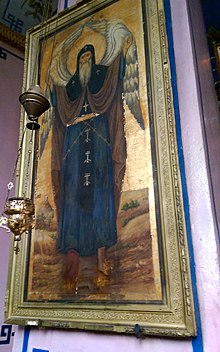Tekle Haymanot
Mandhari

Tekle Haymanot au Takla Haymanot (kwa Kige'ez ተክለ ሃይማኖት takla hāymānōt, kwa Kiamhara tekle hāymānōt, "Mti wa Imani"; Bulga, Shewa, 1215 hivi - Debre Libanos, 1313 hivi) alikuwa mmonaki wa Ethiopia aliyeanzisha monasteri muhimu (Debre Libanos) katika mkoa wake asili, Shewa[4].
Tangu kale anaheshimiwa kama mtakatifu na Waorthodoksi wa Mashariki lakini pia na Wakatoliki[5]
Sikukuu yake huadhimishwa tarehe 17 Agosti, lakini katika Kalenda ya Kiethiopia tarehe 24 ya kila mwezi ni kwa heshima ya Tekle Haymanot.[6]
Tazama pia
[hariri | hariri chanzo]- Watakatifu wa Agano la Kale
- Orodha ya Watakatifu Wakristo
- Orodha ya Watakatifu wa Afrika
- Orodha ya Watakatifu Wafransisko
Tanbihi
[hariri | hariri chanzo]- ↑ Tekle Haymanot is frequently represented as an old man with wings on his back and only one leg visible. There are a number of explanations for this popular image. C.F. Beckingham and G.W.B. Huntingford recount one story, that the saint "having stood too long for about 34 years, one of his legs broke or cut while Satan was attempting to stop his prayers, whereupon he stood on one foot for 7 years." C.F. Beckingham and G.W.B. Huntingford, trans. The Prester John of the Indies by Alfonso Alvarez, (Cambridge: Hakluyt Society, 1961), p. 394n.
- ↑ Paul B. Henze describes his missing leg as appearing as a "severed leg ... in the lower left corner discreetly wrapped in a cloth." Paul B. Henze, Layers of Time: A History of Ethiopia (New York: Palgrave, 2000), p. 63
- ↑ The traveller Thomas Pakenham learned from the Prior of Debre Damo how Tekle Haymanot received his wings:
- One day he said he would go to Jerusalem to see the Garden of Gethsemane and the hill of the skull that is called Golgotha. But Shaitan (Satan) planned to stop Tekla Haymanot going on his journey to the Holy Land, and he cut the rope which led from the rock to the ground just as Tekla Haymanot started to climb down. Then God gave Tekla Haymanot six wings and he flew down to the valley below ... and from that day onwards Teklahaimanot would fly back and forth to Jerusalem above the clouds like an aeroplane. Thomas Pakenham, The Mountains of Rasselas (New York: Reynal, 1959), p. 84
- ↑ This monastery became one of the most important religious institutions of Ethiopia, not only founding a number of daughter houses, but its abbot became one of the principal leaders of the Ethiopian Church, called the Echege, second only to the Abuna.
- ↑ Tekle Haymanot "is the only Ethiopian saint celebrated officially in foreign churches such as Rome and Egypt." Tesfaye Gebre Mariam, "A Structural Analysis of Gädlä Täklä Haymanot", African Languages and Cultures, 10 (1997), p. 184
- ↑ Donald N. Levine, Wax and Gold: Tradition and Innovation in Ethiopia Culture (Chicago: University Press, 1972), p. 73
Viungo vya nje
[hariri | hariri chanzo]- The official Coptic life of Saint Takla Haymanot the Ethiopian
- Biography of Takla Haymanot by Taddesse Tamrat for The Dictionary of Ethiopian Biography Archived 28 Desemba 2010 at the Wayback Machine.
| Makala hii bado ni mbegu. Je, unajua kitu kuhusu Mkristo huyu, kama wasifu wake, habari za maisha au kazi yake? Je, unaona habari katika Wikipedia ya Kiingereza au lugha nyingine zinazofaa kutafsiriwa? Basi unaweza kuisaidia Wikipedia kwa kuihariri na kuiongezea habari. |
